Keywords
|
| AVR microcontroller, Electronic queue control, Low power, Embedded system, Crowd management. |
INTRODUCTION
|
| India has one of the fastest developing economies in the world and is also home to more than one billion people. The population density in India is the highest in the world and is expected to rise over the coming years. 70% of India’s population lives in rural areas. Almost all of them depend on the public services offered by the government for their subsistence. Often the number and capacity of the centres providing these services are limited resulting in overcrowding. People may have to spend a lot of time at the establishment and the lack of transportation facilities in the rural areas only worsens the condition. The intermittent power supply and the lack of immediate response to any power failures in the rural areas mean that the dependence on battery power is inevitable. The low power requirement is a must have feature for all the systems to be used in rural areas. Conventional crowd managing in these public places involve the customers standing in long queues until they get the required service. In some cases, as in that of government offices these queues are often very long and requires the person to wait in the queue for considerable amount of time. This method often proves inefficient with customers made frustrated and discontented. The proposed system is a novel microcontroller based design which obviates long queues, thus resulting in increased efficiency of customer service as well as customer satisfaction. |
| The system discussed here employs the token number mechanism in which customers are given a token number and an array of seven segment displays is utilized to display the token number of customer to be served. Two or more stalls or counters can be implemented to speed up the customer service providing and push buttons provided in each of these stalls control the displayed token number. An LCD provided can give out important news and updates to the waiting customers in real-time. |
RELATED WORKS
|
| Based on previous research many systems have been proposed for efficient management of queue. For instance the PIC microcontroller based electronic queue control system [9] can handle four counters and a total of 100 customers. But the system makes it tedious to keep track of the token numbers being served as the waiting customers have to continuously monitor each of the four counter displays. Also there is no provision to pass any information to the waiting customers and selectively call any token number in case of any emergencies. Another design [10] incorporates a 4x4 matrix keypad to call any specific token number as and when required. The shortcoming of the design is that only one counter can be implemented thus adversely affecting the capability of the system. This system also lacks the feature of real-time information delivery system. An alternate system [11] uses MATLAB interfacing to call out the numbers using a speaker. Although this is effective in getting the attention of customers waiting for their turn, this feature pushes up the overall cost of the system and power requirements. Also only one counter is setup limiting the number of customers that can be served at a time. In [12] the design implements two PIC microcontrollers, one at the counter operator’s side for transmission and another one near the customer for reception. The advantage of the system is that two sets of seven segment display are available on both the customer as well as the operator side. Although the operator can keep a close watch on the displayed token number, the whole design renders the system uneconomical without substantial improvement in efficacy. |
GENERAL OVERVIEW OF THE SYSTEM
|
| The scenario of the working of the system is illustrated as follows: Upon entering the premises of the public service centre, each customer receives a token number. The token number is generally given in the form of a piece of paper or a traditional plastic chip in which the number is engraved. Once the token number is obtained the customer can sit and wait in the lounge or waiting area provided. The customer service can be carried out simultaneously through two or more counters. The service personnel are seated in these counters and can operate a push button provided in each of the counters to call a customer to be served. With each press of the button a token number is displayed on the multi-digit display provided above each of the counters. The customers waiting in the lounge can approach the counter where their token number is displayed. After each service the next customer is called by pressing the button. A sound is also produced for a short duration to intimate about the change in token number. An additional feature of the system is an information display which provides any updates in relation with the token numbers to the waiting customers. It can display the token numbers and display well in advance any breaks or intervals say a break after each session of 100 customers. It can also double up as a source of latest news. This is particularly important at rural places where communication facilities are not so flourished. |
METHODOLOGY
|
| The designing of the system involved accumulating different ideas and determining the methods for implementation of various system features. The following figure 2 aids in explaining the methodology adopted in executing the research which included system design, hardware design, software design and circuit design. |
| The figure below depicts the procedure involved in the research. The procedures commenced with the literary review which involved studies and collecting information on the queue management systems particularly from previous research. The researchers then analysed the existing development state of the queue management system as well as the commercially available systems. Comparisons were made among different proposals to identify flaws of the systems. Problems and short comings were identified and remedies were proposed in the hardware and software design stage. In the integration stage, the hardware design and software design were brought together in a single design. Whenever failure occurred, testing and validating were done to rectify the error. Once the system was perfectly working, researchers proceeded to system discussion whereby experimentation and analysis of the system were carried out. The analysis aided the researchers in illustrating the results as well as reaching a conclusion. |
| A. Hardware Design. |
| The hardware design of the system consists of mainly three sections, Control section, Button press acquisition section and Display and buzzer section. A conceptual block diagram of the system is shown in figure 3. The various sections of the system are explained as follows. |
| 1) Control Section: This section consist of the ATmega32 microcontroller responsible for the controlling of the entire system. ATmega32 is an 8 bit microcontroller from the AVR family of microcontrollers produced by Atmel Corporation. The IC is available in 40 pin DIP package and can work with internal RC oscillator as well as external crystal oscillator. Here for the purpose of queue management we use a 16MHz external crystal oscillator. The microcontroller has built in features like ADC, Timer/Counters, Serial communication ports, Interrupts etc. The IC is very versatile and the In System Programming capability allows the user to program the IC real-time during the development. The IC is equipped with 32 KB flash memory, 1024 bytes EEPROM and 2KB internal SRAM. 16MHz clock speed makes the system operate with very high speed and reliability. |
| 2) Button press acquisition section: The button press acquisition system consists of three push buttons, signal diodes and pull-down resistors. The external interrupt feature of the microcontroller is utilized here. One lead of each push button is tied to a high and the other lead is given to the input pins of the microcontroller. The second lead of each push button is connected to the external interrupt pin of the microcontroller through a signal diode. The signal diodes serve the purpose of isolating the high signal of a button from the other buttons. This results in correct identification of the switch being pressed. The pull-down resistors serve the purpose of tying the input pins to ground. When the button is pressed, the high signal drops across these resistors and thus providing a high at the input pins. When the button is not pressed, the pull-down resistors keep the pins at a low level. |
| 3) Display and buzzer section: This section includes three pairs of seven segment displays, a liquid crystal display and a buzzer. The seven segment displays used here are common anode seven segment displays. In-order to display the required number a low signal has to be given to the pins of required LEDs. The six led display are used in a time multiplexed manner that is enabling the displays only one at a time for extremely small duration. Due to persistence of vision of the human eye, all the displays appear to be turned on at the same time. The LCD or liquid crystal display is capable of display alpha numeric characters and is a versatile device. |
| B. Software Design. |
| The software design of the system was done in C language. C language offers better flexibility and more easiness of programming and debugging. The program was burned to the ATmega32 microcontroller using the USBASP programmer. The compilation of C language program to hex file was done using the popular GNU based WinAVR GCC. It offers additional functionality of burning the program to the IC. The USBASP programmer utilizes the In Serial Programming capability of AVR microcontrollers and thus makes it possible to program the IC real-time during development. The flow chart of the program which illustrates the procedures in software design is shown in figure 4. |
| C. Integration of hardware and software. |
| Once the hardware is setup, the program is burned to the IC using the IC programmer. The power supply is give from mains through LM7805 voltage regulator which regulates the input voltage to +5V level. The system can work well with battery also. The circuit diagram of the system is shown in figure 5 given below. |
RESULTS AND ANALYSIS
|
| A miniature working model of the proposed AVR microcontroller based intelligent queue management system was successfully designed and implemented. The system was tested at the stationary store in the researcher’s college campus. Minor changes were included in the software to make the system more adaptive to the environment. The three counters/stalls setup could reduce the bustling in the store to a great extend and made the environment very calm and orderly. The students waiting for their turn could indeed take some time off from their busy schedule and socialize with their fellow students. Several studies were done on the system to analyze the efficacy of the system in that particular scenario. The studies could give an estimate of performance of the system in various environments. |
| A. Maximum queue length |
| The system could easily handle crowds more than hundred but involved much more frequent overflow resetting of the token numbers. This in turn gave the advantage that the same set of tokens made for the system could be reused, without having to produce them more than hundred in number. |
| B. Number of stalls. |
| The number of stalls had a great effect on the effectiveness of the system. It enabled the store operators to handle three customers simultaneously resulting fast and efficient response and reduced customer waiting time. |
| C. Cost of the system. |
| The system is very much cheaper compared with the commercial model available in the market. As the components used are cheap and easily available, the overall cost is kept at a low value which could be brought down if mass produced. It highlights the prospective application of the system at rural public places where a number of such systems are required at a low price. The entire design can be optimised to match the prerequisites of different working environments. |
| D. Power requirements. |
| The most important aspect of the system is its ability to work with stored DC power for a long time. The low power requirement not only leads to savings in utility bill, but also makes the system very much versatile. It is particularly helpful at remote locations where stand alone solar panels are used for power generation. Frequent power outages and load shedding have little effect on the system giving it added advantages. |
| E. Real-time information display. |
| The unique feature of the system is the real time information display system. The LCD display provided updates the waiting customers about the token numbers being served across all the stalls. The customers are thus required only to keep watch of this single display instead of continuously monitoring all the three stalls. Also the display gives out message regarding time out sessions. The number of customers served in between each session can be easily programmed. Additional information can be provided by programming the microcontroller as required. The downside is that the application of this feature is limited by the programming knowledge of the operators. |
CONCLUSION
|
| A novel intelligent system for quick and efficient management of queue with three stalls/counters and up to a hundred customers serving in a single session has been designed. The system was tested and studied in an environment similar to public places and the performance of the system has been analyzed. Figure 6 shows the miniature model of the designed system. The proposed system may seem simple in design but it has wide range of practical applications in our daily lives. The system brings about quick and easy management of queue with very little cost and can be successfully implemented in medium crowd environment. The low power requirements and easiness in configuration greatly enhances the portability if the system enabling it to be used with battery for sufficient amount of time. The reliability of the system can be enhanced by future modifications and the cost can be further brought down by mass production. |
| Future modifications includes ability to automatically call out token numbers using loudspeaker and increasing the total number of customers handled to thousand using three seven segment displays for each counter. The number of stalls could be increased beyond three to further improve the effectiveness. Ability to enter desired token number manually could increase reliability under emergency circumstances and the real-time information delivery system could be improved upon to deliver dynamic news and information. |
ACKNOWLEDGMENT
|
| We would like to thank God Almighty for blessing us with to successfully complete this research. We also express our sincere thanks to Prof. K. Radhakrishnan, HOD of Dept. of Electrical and Electronics, and to assistant professors Ms. Jeena Joy and Mr. Eldhose K.A. of M.A. College of Engineering, Kothamangalam for the valuable assistance provided towards the completion of this project. |
Figures at a glance
|
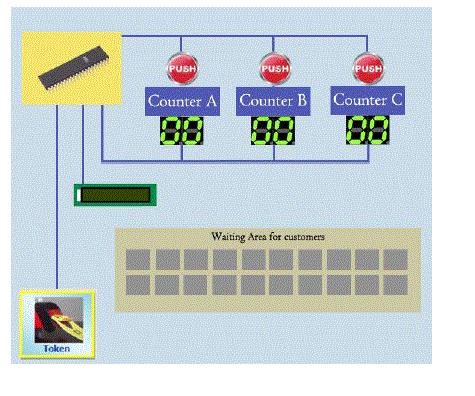 |
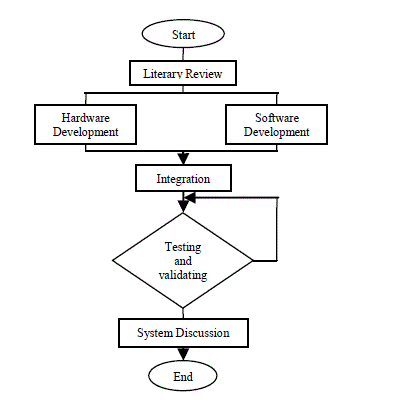 |
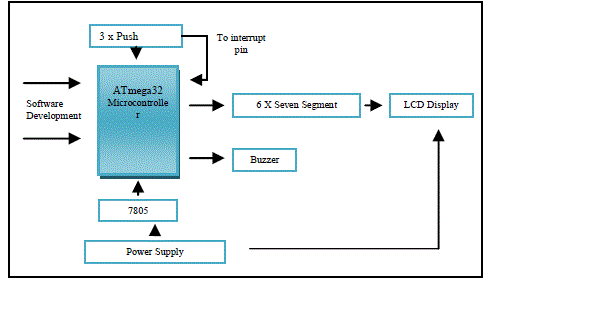 |
| Figure 1 |
Figure 2 |
Figure 3 |
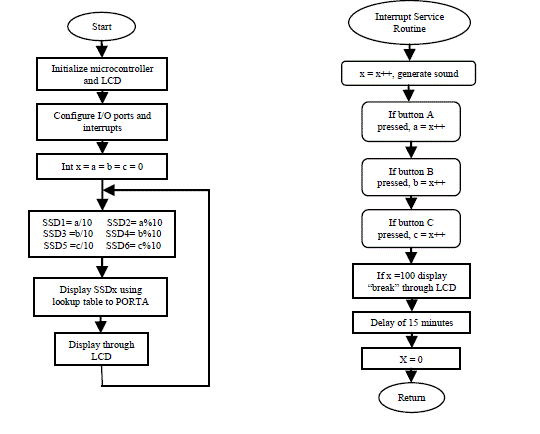 |
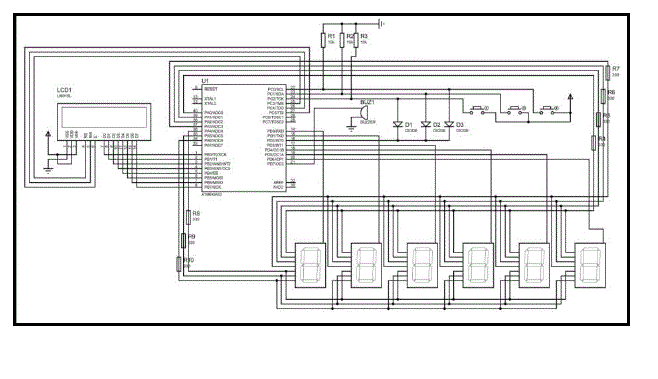 |
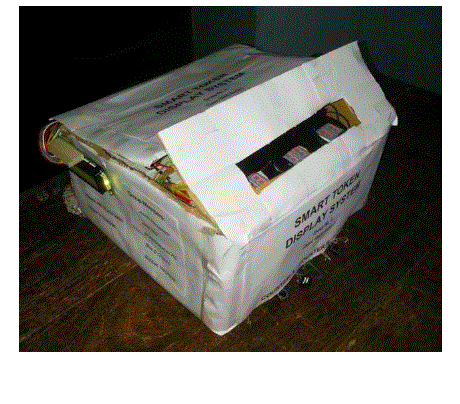 |
| Figure 4 |
Figure 5 |
Figure 6 |
|
| |
References
|
- “ATmega32 data sheet,” Atmel Corporation, U.S.
- (2012) AVR Libc home page. Online.. Available: http://www.nongnu.org/avr-libc/
- Richard Barnett and Sarah Cox, Embedded C Programming and the Atmel AVR, 2nd ed., R. M. Delmar Thomson Learning, 2006.
- DhananjayGadre, Programming and Customizing AVR Microcontroller, 1st ed., Tata McGraw Hill Education, 2003.
- Richard Barnett and Sarah Cox, Embedded C Programming and the Atmel AVR, 2nd ed., R. M. Delmar Thomson Learning, 2006.
- (2012) Newbie Hack home page. Online.. Available: http://www.newbiehack.com/
- (2013) Extreme Electronics home page. Online.. Available: http://www.extremeelectronics.co..in/
- Muhammad Ali Mazidi, The AVR Microcontroller and Embedded Systems, 1st ed., Pearson, 2012.
- M.B. Hossain, M.N. Hossain, M.M. Hossain, and M.H. Rahman, “Design and Development of Microcontroller Based Electronic Queue Control Systems,” in Proc. IEEE Student’s Technology Symposium, pp. 48-52, Jan. 2011.
- R.K. Megalingam, Sreenath P.S, D. Soman, Jessin P.A. and Srikanth S, “Low Power Microcontroller Based Simple Smart Token Number Display System,” in Proc. Fifth IEEE International Conference on MEMS NANO and Smart Systems, pp. 171-175, 2009.
- M. Mamun, A.H.M.Z. Karim, and M.I. Mahbub, “Low Power Microcontroller Based Intelligent Token Number Speaker and Display System,” IACSIT International Journal of Engineering and Technology Vol.3, No.2, PP. 199-202, April 2011.
- S.S. Htwe, M.T. Oo, and H.N. Win, “Remote Token Display System Using Microcontroller,” World Academy of Science, Engineering and Technology, pp. 134-140, 2008.
|